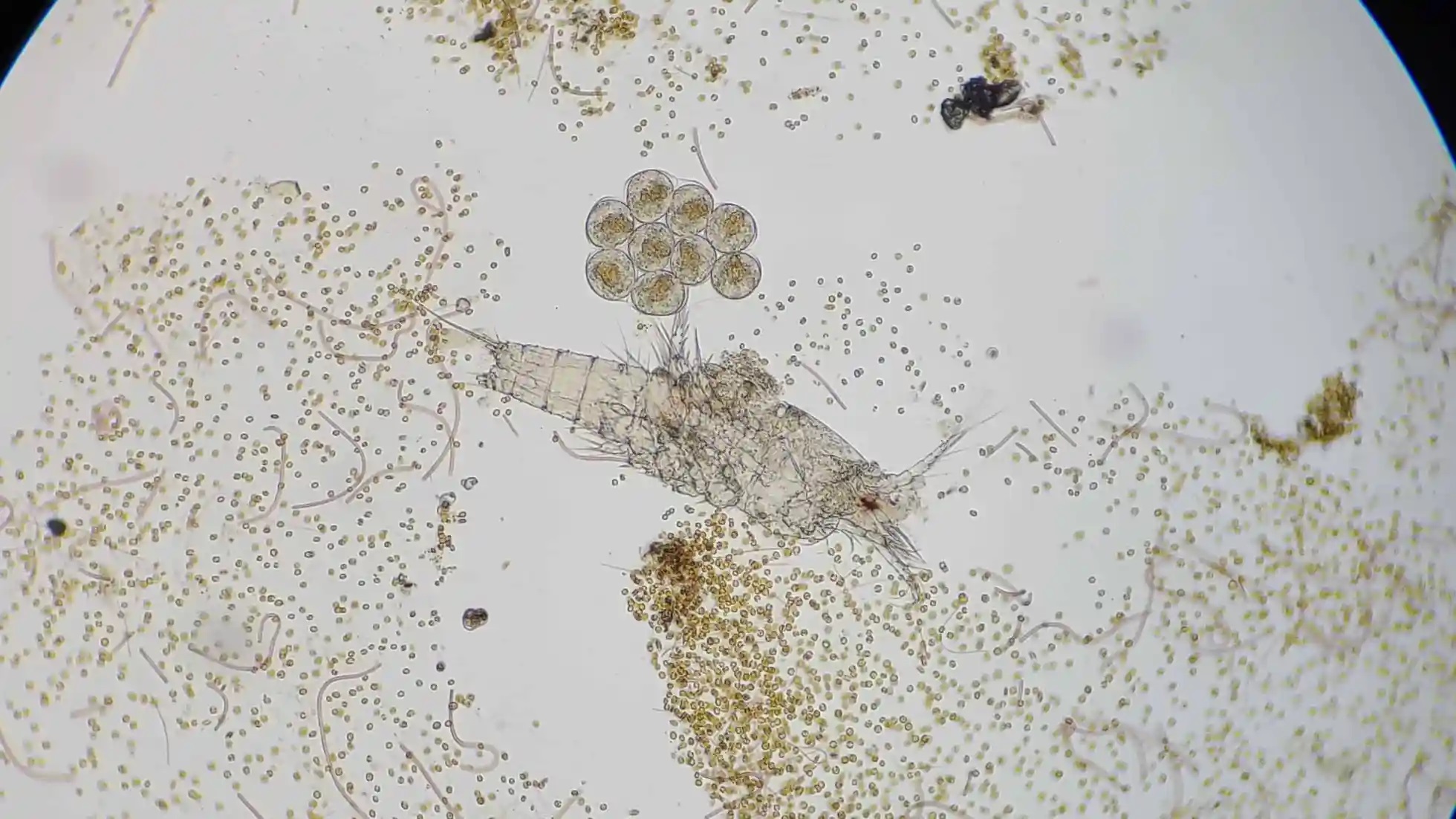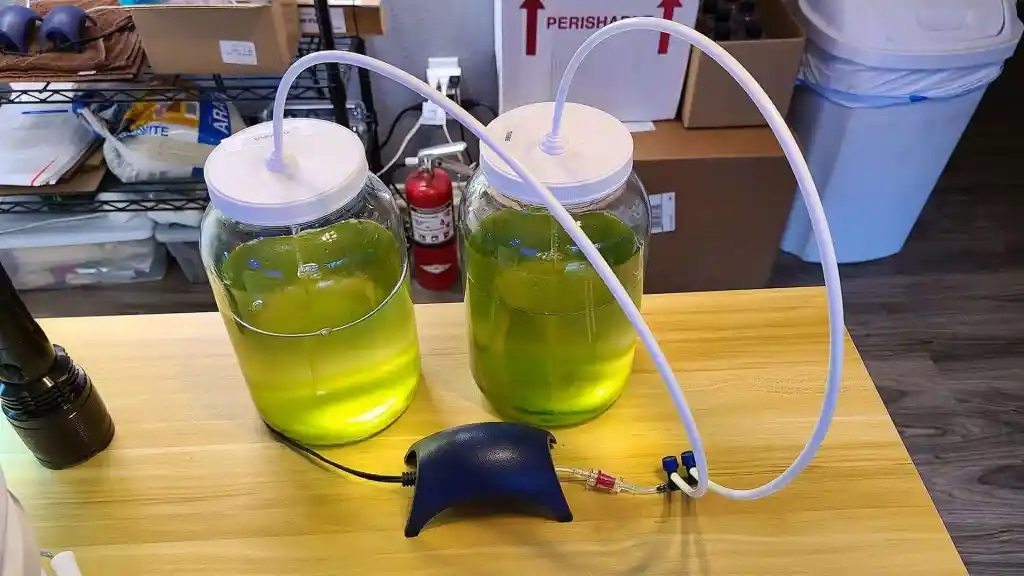Full in depth guide to growing copepods at home
Table of Contents
What are Copepods?
Copepods are a type of small crustacean found in marine and freshwater environments around the world. They are among the most abundant animals on the planet and play an important role in aquatic ecosystems. There are approximately 12,000 identified species of copepods. The most common copepod species that are cultured in the reef tank aquarium hobby are tisbe biminiensis, tigriopus californicus, apocyclops panamensis, parvocalanus crassirostris.
Copepods are typically less than 1 millimeter in length and have a distinctly segmented body with a head, thorax, and abdomen. They feed on plankton such as phytoplankton, detritus, and other organic matter and, in turn, are eaten by larger aquatic organisms such as fish larvae and even corals. Copepods are important indicators of water quality and play an important role in nutrient cycling in aquatic environments.
Breeding supplies
To culture copepods, you will need the following supplies:
Copepod starter kit
You want to make sure you have a trustworthy and reliable source for non-contaminated copepod starter cultures. Otherwise, in due time you will be culturing more than what you originally thought you were buying.
Phytoplankton starter kit
Phytoplankton is the food that copepods eat. This will be one of the main diets for your copepods. Copepods will eat almost anything. Afterall, they are scavengers near the bottom of the food chain. You should keep the water slightly tinted green with phytoplankton. Check your cultures daily and don’t over feed, because this will lead to a culture crash. Copepods will also graze on film algae that grows on the walls of your container as well as the mulm and detritus that collects on the bottom of the container.
It is also very important to buy a clean source of phytoplankton. Some vendors will use old techniques and use Miracle-Gro fertilizer to grow their phytoplankton and this is not something you want in your aquarium. You want to make sure it has been grown with Gaillard’s formula f/2. If you can find phytoplankton that is non-contaminated, that is a bonus. Typically, these are very expensive starter cultures that can be found at college labs such as UTEX.
Copepods for Sale
These are the most common copepods use to start breeding:
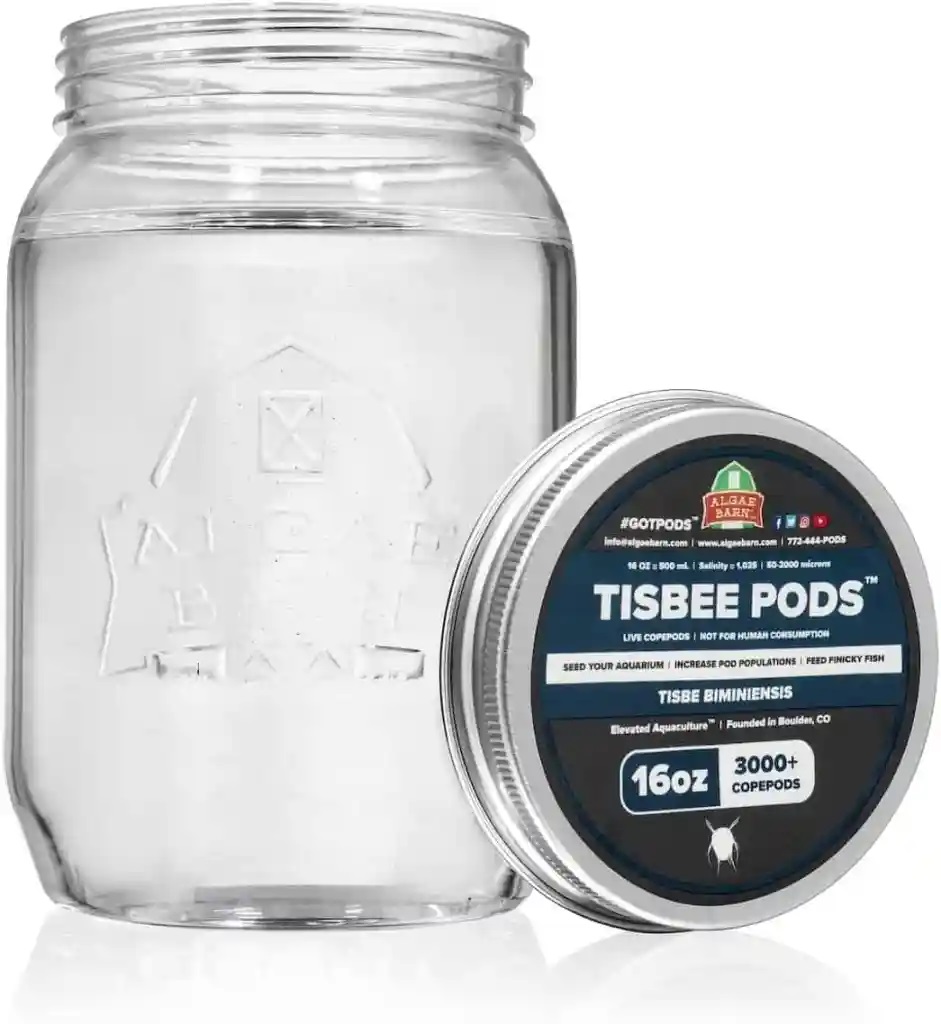
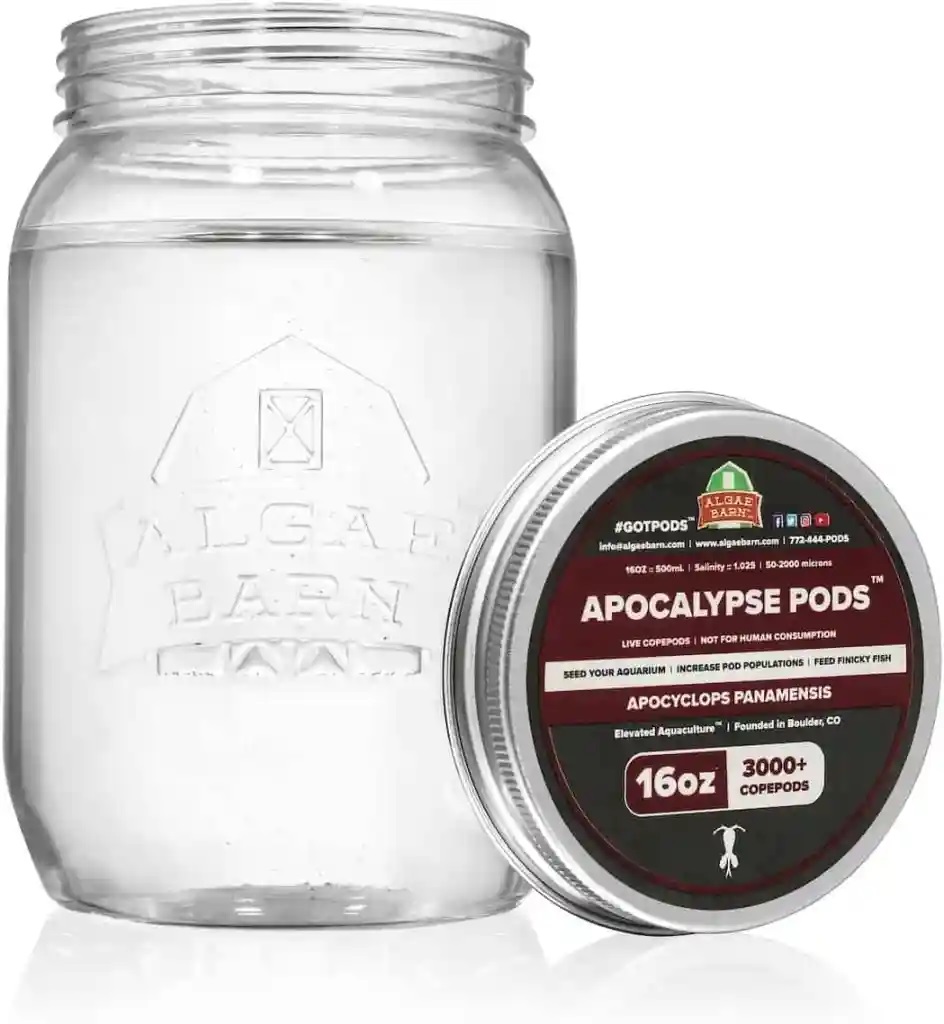
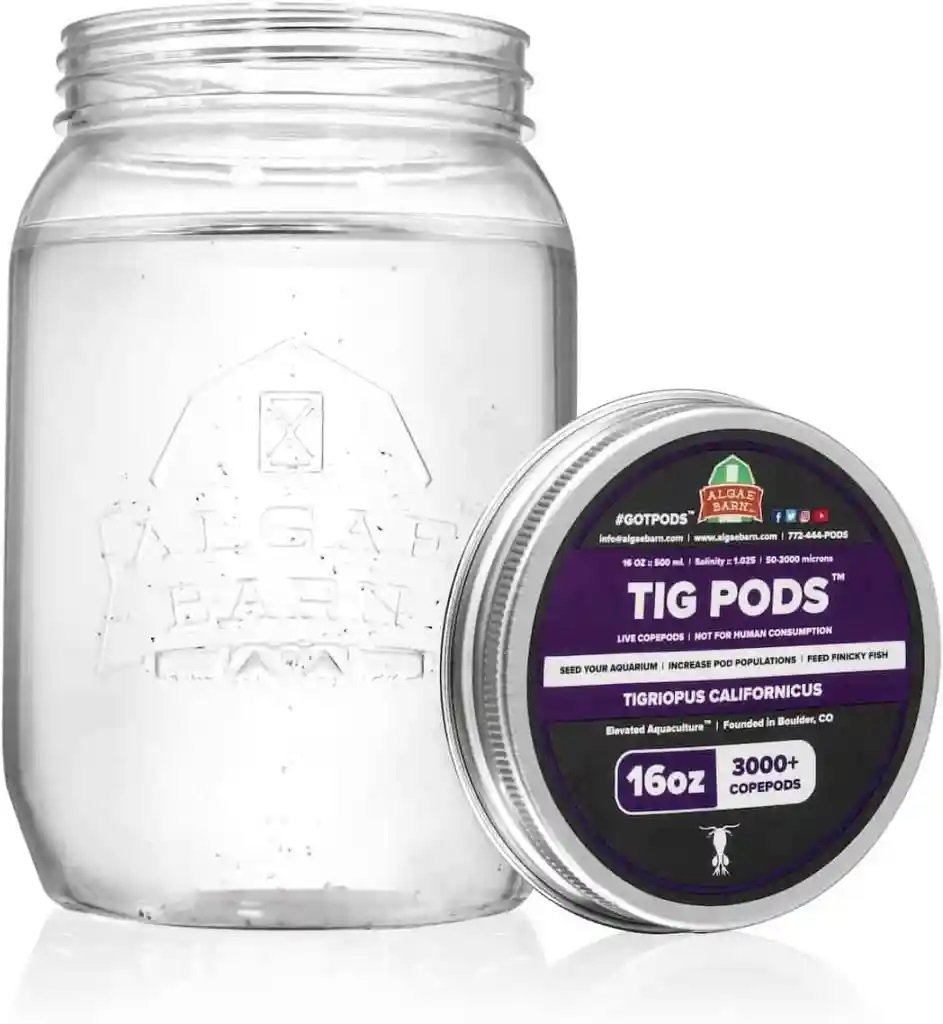
Culturing vessel
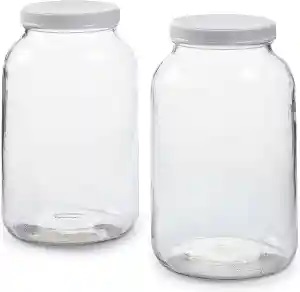
Glass is preferred but lab grade plastic or food grade plastic such as those containers found at a brewing store will work fine as well. I typically like to start my new cultures in 1-gallon containers to let the copepods find each other and reproduce quicker. I will then split this culture into two more 1-gallon cultures so I have a backup in case one crashes. After that I will slowly move a copepod culture up in size to a 2- or 3-gallon container, then eventually into a 10-gallon aquarium.
Start off with freshly made RODI or Reverse Osmosis Deionized water. I mix my salt to a specific gravity of 1.023 – 1.026 depending on the species of copepods I’m culturing. You do not want to use tank water because other unknown microorganisms can and will outcompete pods in due time.
Lighting
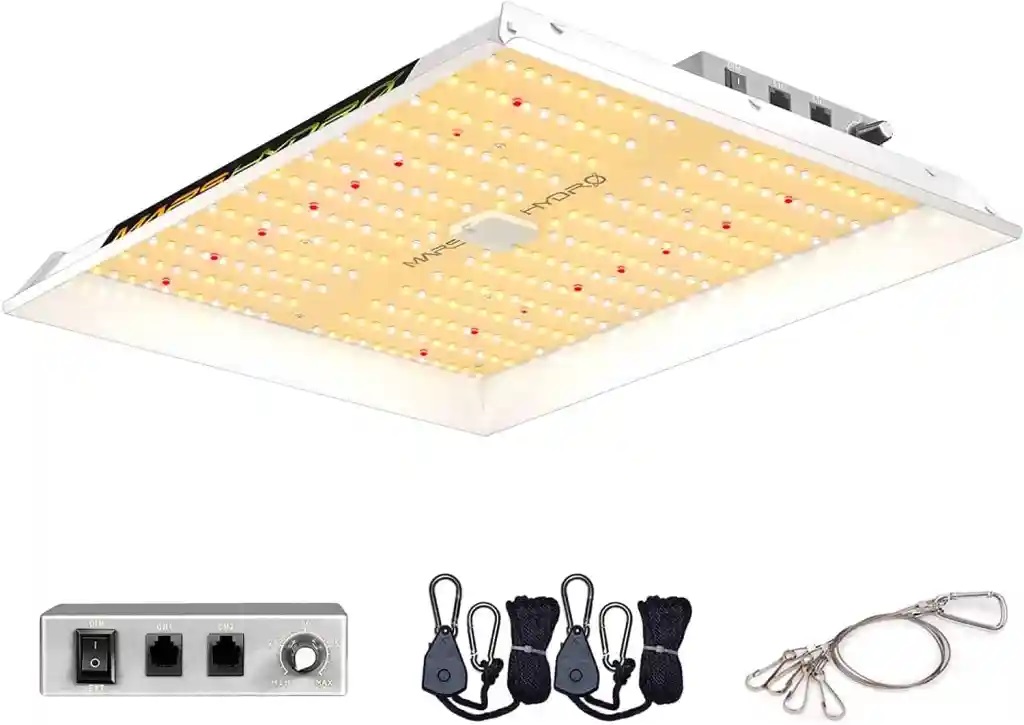
Copepods do not require a light, but a light will speed up the film algae growth on the surface of your culture vessel. All of the detritus and mulm on the bottom of your aquarium will only fuel faster reproduction ion your copepods as this is their natural diet. The brighter the light, the faster film algae can grow on the walls of your culture container. I personally use these Mars Hydro TS1000W led lights on my copepod and phytoplankton cultures and they work very well.
Heater
Depending on the temperature of the room you are culturing copepods in, you may need a heater. It would also be wise to use a heater in the winter. As temperatures drop, so does the reproduction rate of copepods. Generally, anywhere from 75-80 is a preferred range for copepods to thrive in, depending on species.
Air pump
This is the main lifeline for copepods. It does not have to be an industrial sized air pump. A small, reliable and quiet air pump will do the job.
Aquarium Air hose
Stock up on plenty of aquarium air hose as you will go through a lot more of it than you think you need. It is best to but the thicker premium air line hose as it will fit into all of the fittings easier that the cheaper thinned walled airline.
Air stone
Nothing too special to mention here. Just make sure you get the air stones that are made of fine grit or stones. You do not need wooden air stones. Although they are nice and will work, the wooden ones will gunk up quicker and are a wasted expense. Pick up at least 8-12 air stones.
Adjustable Air Valve
This is used to precisely control how much air is going into the water in your culturing vessel. Any aquarium types will do, but the more premium ones seem to be made out of better quality plastic, the seal lasts longer and they are overall easier to fine tune and adjust.
Check Valves
A check valve will only let air flow in one direction. If you have one connected to your air pump and the power goes out, water cannot back flow into your air pump. If the electricity were to suddenly turn back on while water was in your air pump, that could cause an electrical short and a fire. Check valves are really only meant to help prevent a siphon so if your air pump was kept above any water source you will be fine. I like to play it safe and install them on every air pump I use. You never know when you may need to rearrange your culturing setup and you move your air pump below a water source. Don’t skimp on this. They are cheap and will prevent a fire.
Gang valve
A gang valve is used to route the air from a single air pump to multiple external sources. If you plan to culture multiple species of copepods, it may best to buy a more powerfully air pump and hook it up to a gang valve. Then connect all the outlets to each culture container.
Sieves
Sieves are a tool used to catch and filter out copepods from the water. They are typically made using 4” PVC tubing and a fine nylon mesh material in different sizes. The main sizes you will need are 52 µm and 120 µm. 53 µm is a finer mesh size, so less matter will go through it. 120 µm is a larger mesh size and it typically used to only collect the adult copepods and allow the nauplii and larve to pass through. For size reference, there are 1000 µm (micro meter) in 1 mm.
Beneficial bacteria
Although beneficial bacteria are not actually necessary. I prefer to add Dr. Tims One and Only bacteria to my cultures a week or two before I add copepods so the cycle is not as stressful on the pods. They can do fine without a typical cycle but I would rather have the beneficial bacteria there to help speed up the initial ammonia phase.
Contrary to popular belief you do not need to add live sand, live rock or macro algae into your cultures. If you add any of these you could contaminate your copepod culture with other unknown microorganisms that could outcompete your copepods.
Video on How to grow Copepods at home
Growth, reproduction and life cycle
Copepod Size reference (approximate)
Name Size (um) Lifespan Egg to breeding age
Tisbe 50-850 30 days 7-10 days
Tigger 250-1500 30 days 20-30 days
Apex 100-700 7 days 2-3 days
Copepod growth stages
Nauplius Stage:
This is the earliest stage of a copepod’s life cycle. The nauplius has a simple body structure consisting of only three parts: a head, thorax, and abdomen. At this stage, the copepod has no stomach and is only capable of swimming.
Copepodid Stage
This is the second stage of a copepod’s life cycle. Copepodids have a more complex body structure than nauplii, including a pair of antennae, a pair of eyes, and several pairs of swimming legs. Copepodids are capable of both swimming and feeding.
Adult Stage
This is the final stage of a copepod’s life cycle. Adults are similar in body structure to copepodids, but have a larger body size and are capable of reproducing. Adults are also capable of more complex behaviors, such as seeking out prey, avoiding predators, and navigating their environment.
Copepod reproduction cycle
Copepods have a complex reproductive cycle that involves alternation between asexual and sexual reproduction, depending on the species and environmental conditions.
Asexual Reproduction: In the asexual stage, the female produces eggs that develop into nauplii, which are the first larval stage. Nauplii molt several times and eventually become juvenile copepods. As adults, copepods are able to reproduce asexually through parthenogenesis, where unfertilized eggs develop into viable offspring.
Sexual Reproduction: During the sexual stage, copepods mate and the female produces eggs that develop into advanced larvae. The larvae may molt several times before becoming juvenile adults, which will eventually mate and produce more eggs.
The reproductive cycle of copepods is typically influenced by environmental conditions, such as temperature, food availability, and photoperiod. These environmental factors can cause changes in the number of eggs produced by a female and the length of time required for the eggs to develop into adults.
Copepod life cycle
Copepods have a complex life cycle that typically involves several stages of metamorphosis. Generally, the life cycle begins with an egg stage, which hatches into a nauplius larva. The nauplius larva goes through several stages of development before becoming a juvenile copepod. As adults, copepods may reproduce either sexually or asexually. Most species produce between one and three generations of offspring per year. When conditions are favorable, some species may produce up to seven generations per year.
Copepods are a type of aquatic invertebrate that has a complex life cycle. They are able to reproduce asexually by mitosis, but are most commonly reproduced sexually. In both cases, the copepods undergo a process of fertilization and then give birth to offspring.
Copepods undergo a process of fertilization where the male copepod uses a specialized organ to transfer sperm to the female copepod. The sperm then enters the female copepod’s body and fertilizes her eggs. The eggs then hatch into planthoppers and the planthoppers undergo another process of growth and development before they become copepods themselves.
What are the benefits of growing copepods?
Copepods are a major part of the aquatic food chain, providing an important food source for fish such as Mandarin Gobies, Ruby Red Dragonets, Scooter Blennies, Leopard Wrasse, Pipefish, Copperband Butterfly fish and many other fish. These fish need to eat multiple times throughout the day. Most reef fish will eat pods if they have the opportunity to do so, However the fish mentioned above eat pods as their main diet.
Copepods are also used in raising fry when breeding fish. Most fish will start out eating rotifers, then graduate to copepods and shortly thereafter start eating pellets, flakes or frozen food. The most common fish that is bred in this hobby and their fry needs copepods is the Clownfish. In addition to feeding fry and fish, corals will also eat copepods.
- They are efficient natural filters, removing excess nutrients and organic matter from the water.
- Copepods can be used as a natural biological control for reducing algae blooms and other pests in aquatic systems.
- They are a source of valuable proteins and fats for fish, corals and other aquatic species.
- They are a natural source of carotenoids, which can enhance the color of fish.
- Copepods are relatively easy to culture, making them an ideal food source for aquaculture operations.
Copepods have a number of unique benefits that can be useful in various industries. They are a valuable source of food for many marine organisms. Copepods are a very important part of the marine ecosystem and play a vital role in the aquarium food chain.
Why you should breed copepods
- Copepods provide a natural source of food for many fish, juvenile and adult, which can help to improve their health and growth cycles exponentially.
- Copepods can help to reduce the amount of film algae on the glass of an aquarium as they feed on it.
- Copepods are a great source of protein for fish and corals, which can help to promote growth and coloration.
- Copepods are an important part of the tank’s biological filtration as they consume detritus and help to keep the water cleaner.
- Copepods provide a natural “clean up crew” which can help to keep the tank free of some microscopic pest organisms.
How can copepod cultures be improved?
- Increase water temperature and quality: Copepods thrive in warm water with good salinity, pH and oxygen concentrations.
- Feed them regularly: Feeding them regularly with a variety of food sources will ensure they are getting the nutrients they need to grow and reproduce.
- Increase oxygen levels: Providing adequate oxygen levels to the culture will ensure the copepods can breathe properly.
- Reduce light levels: Reducing the light levels in the culture will help reduce stress and encourage the copepods to breed.
- Utilize live cultures: Live cultures of copepods are more likely to reproduce and thrive in a culture than a single species culture.
- Reduce stress: Reducing stress levels in the culture will help the copepods to remain healthy and reproduce.
- Monitor water parameters: Monitoring the water parameters such as pH, temperature, oxygen levels and salinity levels on a regular basis will help maintain a healthy culture.
- Utilize filtration: Utilizing filtration in the culture will help remove debris and uneaten food, as well as reduce the risk of bacterial and fungal growth.
Copepods are a type of crustacean that inhabit the oceans and can be found in a variety of environments. They are important in the food chain and are used as a food source for a variety of organisms. Copepods can be cultured in a number of ways and can be used to study various aspects of their biology.
One way to improve copepod cultures is to increase the diversity of the cultures. This can be done by adding different types of microorganisms or culturing different types of copepods. Another way to improve copepod cultures is to increase the number of cultures. This
Benefits and drawbacks of growing copepods.
Benefits:
Culturing copepods has numerous benefits. Firstly, it is a great way to produce a large amount of food for other aquatic species. For example, cultured copepods are often used as food for fish, corals, and other invertebrates. Secondly, culturing copepods can help to maintain a stable and healthy population of copepods that can be used as an important part of the food web in an aquatic ecosystem. Thirdly, copepods can be used as a natural form of biological filtration, as they help to break down waste and keep the water clean. Finally, culturing copepods can provide additional income for aquaculture farms, as they can be sold as a live food source for other species.
Drawbacks:
There are a few drawbacks to culturing copepods. For one, copepods are very small and can be difficult to keep in culture. Additionally, culturing copepods can be time-consuming, and it can be difficult to determine the success or failure of a culture. Lastly, copepods are not particularly nutritious, and culturing them can be expensive.
Difficulty in culturing
Culturing copepods is difficult and can be very time consuming. Due to their small size, they can be difficult to handle and require special equipment for their successful maintenance. Additionally, culturing copepods can be difficult because the species vary so much in their nutritional requirements.
Cost
The cost of maintaining copepods in a lab setting can be quite expensive, as there is a need for specialized equipment, food and housing materials.
Contamination
Copepods are highly susceptible to contamination, and it is difficult to maintain a clean environment. This can lead to the spread of disease and can have a detrimental effect on the health of the copepods.
Lack of genetic diversity
Copepods are a limited resource, and it can be difficult to obtain new specimens with a different genetic makeup. This can lead to a lack of genetic diversity in the population, which can reduce the overall health of the ecosystem.
Additional tips for culturing copepods.
Throughout the past several years as I have been growing copepods and culturing phytoplankton as a hobby, I have made several discoveries that really helped me to become successful in culturing copepods. It did not happen overnight, by reading articles or watching YouTube. Though this helped for inspiration, you have to put in the time, work and really be dedicated to wanting to be successful. These are some of the lessons I’ve learned over the past 7 years.
Grow several strains of phytoplankton.
The more different types of food you can feed to copepods, the happier and healthier they will be. I currently grow Nannochloropsis Oculata, Tetraselmis Chui, Isochrysis Galbana, Dunaliella, Porphyridium Cruentum, Chlorella Vulgaris and Arthrospira plantensis and have experimented with feeding each of these to my copepod cultures.
Natural Food for Copepods
Copepods will do very well in an environment void of phytoplankton as long as it is abundant in film algae, detritus or mulm and fish waste. Copepods do not get hand fed phytoplankton in the ocean like we feed them in out homes. We forget that copepods have been around for a long time and they have done well without us. Copepods will eat just about anything they can find, and they will survive. Do not overfeed with phytoplankton and let nature run its course and clean up.
Grow copepods in larger systems to allow parameter fluctuations to not disturb copepods
In the beginning I used to struggle with culturing copepods because I would use small water bottles. Once I invested a small amount of money and started using larger containers such as 10-gallon aquariums I saw an explosion in growth in every system very rapidly. To the point that it was a must to harvest constantly because there was very little room left on the glass for more pods to populate.
Stick with 1 species of copepods and culture it until you understand them inside and out
The longer you study and culture one single species of copepods the quicker you will understand their needs and how to help them thrive in an artificial environment. Don’t focus on culturing several strains at once in the beginning because although these “aquarium hobby” copepods have all very similar needs, they each thrive in a slightly different environment separately.
Educate yourself on the science behind these amazing creatures
Read books, articles, research papers and watch YouTube videos on copepods and other zooplankton. You will be amazed at how much information is out there. Its overwhelming to a point at times. You don’t have to know everything about every specific detail but the knowledge is there.
Document what you learn
Take all the notes you can even though you don’t think it is important at first. You can learn so much from the successes and failures of each culture your try. I have notebooks filled with somewhat organized notes on each culture I attempted. Each time I started a new culture I referenced my notes to replicate it and change one thing to see if that change made an impact or not. Once I found a “recipe” that worked I set it aside and set it as a SOP and followed it each time I wanted to start a new culture.
Share the knowledge.
There are a lot of people wanting to grow copepods for profit. There’s nothing wrong with that. I feel like there are those out there who seem arrogant to the point that in my eyes they think they have learned a secret in life that no one else must ever know or find out or they may lose out on a $20 sale of bugs in a bottle. There are great groups and websites out there that people will help you help grow copepods and phytoplankton. Don’t forget that we once knew nothing and don’t forget to share your knowledge with those who just want to learn. Regardless if they want to grow copepods for their own tank or “strike it rich” by being the next Reef Nutrition or Algae Barn.
Frequently Asked Questions
How do I feed my culture?
To feed copepods you can simply pour phytoplankton into your culturing vessel until it is lightly tinted green. If the water becomes clear between feedings, do not worry. As long as there is phyto-mulm, detritus or algae on the floor/walls of your culture, the copepods will have plenty of food to eat for a short time. However, you will need to begin to increase the amount of phytoplankton you are feeding to keep up with the demand of the increasing population.
How to do a water change, and how often?
Do WC every 3-4 weeks or more often if water parameters say so. Copepods do not need pristine water. As long as they fall within the acceptable water parameters, copepods will survive just fine. To change the water, it is best to use ½” tubing and siphoning the water out. You will need to use a sieve so your copepods do not go down the drain.
Also, mark a line on your culture vessel at the water line when you first fill it up so you know what level to fill your vessel back up to when topping off with RODI water. Don’t forget to top off regularly with RODI water!
How long does it take before I see new pods in my culture?
Typically, you will see new copepod larvae after 30 days.
How to harvest copepods?
To only collect adult copepods, use a 120 um sieve. If you want to catch adult and nauplii copepods use a 53 um sieve. After collecting pods in either sieve you can then put this sieve into a new vessel to start a new culture, put them back in the original vessel or put it in your aquarium to feed the tank.
Copepods in reef tank
If you just purchased some copepods you will want to put the bottle or bag in your reef tank to let it temp acclimate to your aquariums temperature in order to not shock the copepods. It is recommended to add your copepods in the refugium chamber of your sump while the lights are off. Also, turn the skimmer off for at least 2 hours before and after adding copepods to your sump to avoid having them pulled out.
Summary and conclusion
Copepods are a very beneficial food source for your reef aquarium. Fish and corals will eat copepods and thrive as it’s a natural food source for them in the wild. With just a small investment in supplies you can grow your own copepods at home and have an unlimited natural food source to feed your aquarium’s inhabitants.


